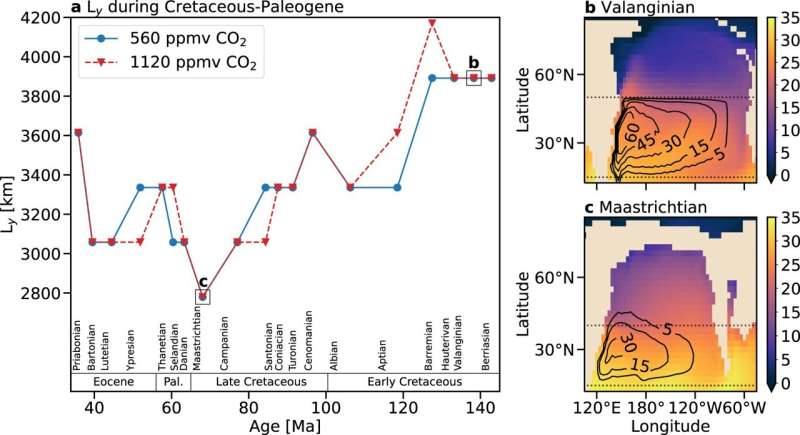This article has been reviewed according to Science X's editorial process and policies. Editors have highlighted the following attributes while ensuring the content's credibility:
fact-checked
peer-reviewed publication
trusted source
proofread
Study reveals previously unknown mechanism impacting Earth's climate

A study has unveiled a previously unknown mechanism that significantly influences Earth's climate.
This cutting-edge research, published in Nature Communications, applies a novel analytic model developed by the three Hebrew University researchers two years ago, focusing on wind-driven circulation at the ocean's surface and highlighting the pivotal role of ocean basin geometry.
This study explores the climate during the Cretaceous period, around 145 to 66 million years ago, when there was a lot of a carbon dioxide (warming gas) in the air. It looks at how big ocean swirls, which move warm water from the tropics to the poles, influenced the temperature difference between these two regions. This temperature difference is crucial for understanding why there were so many different kinds of plants and animals during the Cretaceous period.
In their research, the scientists aimed to uncover the complex relationship between changes in ocean current patterns (gyral circulation) that result from the arrangement of continents on Earth and variations in temperature gradients during the Cretaceous era when dinosaurs roamed the Earth. To do this, they conducted a thorough analysis using computer models that simulate ancient climates.
Their findings revealed that the movement of Earth's continents during the Cretaceous period caused a slowdown in the large swirling ocean currents responsible for carrying warm water from the equator to the poles. This slowdown disrupted the way the ocean regulated its surface temperatures, resulting in a significant increase in temperature differences between the poles and the tropics during that time. These findings align with geological evidence from the Cretaceous era, providing a more comprehensive understanding of past climate dynamics.
Findings
- Implications for contemporary climate: While the study primarily focuses on the Cretaceous period, it has implications for our understanding of contemporary climate systems. It highlights the importance of ocean gyres (circulation patterns) in shaping climate dynamics, both in the past and today. It underscores the complexity of Earth's climate and the strong effect that processes other than CO2 concentration might have on it.
- Focus on Cretaceous period: The research primarily focuses on the climate during the Cretaceous period, which occurred approximately 145 to 66 million years ago. This period is of interest because it was characterized by high levels of carbon dioxide in the atmosphere, which is a greenhouse gas that can influence global temperatures.
- Role of ocean swirls (gyral circulation): The study investigates the role of large ocean swirls, known as gyral circulation, in transporting warm water from the tropics to the poles. Understanding how these currents influenced temperature differences between the poles and the tropics is crucial for comprehending the biodiversity and climate of the Cretaceous period.
- Impact of continental movement: The research findings suggest that the movement of Earth's continents during the Cretaceous period disrupted the large ocean currents responsible for transporting warm water. This disruption led to significant increases in temperature differences between the poles and the tropics during that time.
- Validation with geological evidence: The study's findings align with geological evidence from the Cretaceous period, providing further support for the proposed mechanisms and enhancing our understanding of past climate dynamics.
In summary, this research helps us gain insights into the complex relationship between ocean circulation patterns, equator-to-pole temperature differences, and past climate conditions. While it primarily contributes to our understanding of Earth's ancient climate, it also underscores the significance of oceanic processes in shaping contemporary climate systems. This knowledge can potentially aid in modeling and predicting the impacts of climate change in the modern era, as ocean circulation patterns continue to play a crucial role in regulating global climate.
The research was conducted by Hebrew University's Ph.D. candidate, Kaushal Gianchandani, under the guidance of Professors Nathan Paldor and Hezi Gildor from the Institute of Earth Sciences at the Hebrew University, in collaboration with Prof. Ori Adam and Sagi Maor from the Hebrew University along with Dr. Alexander Farnsworth and Prof. David Lunt from the University of Bristol, U.K.
More information: Kaushal Gianchandani et al, Effects of paleogeographic changes and CO2 variability on northern mid-latitudinal temperature gradients in the Cretaceous, Nature Communications (2023). DOI: 10.1038/s41467-023-40905-7
Journal information: Nature Communications
Provided by Hebrew University of Jerusalem




















